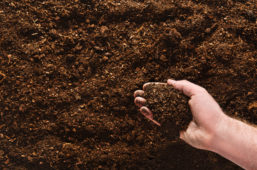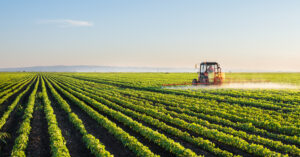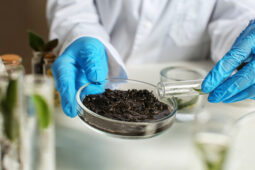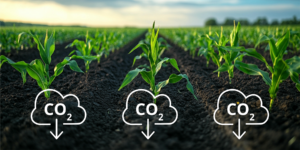By: John Gorsuch, Vice President of Research and Development, BiOWiSH Technologies
Did you know that certain microbes can partner with plants to enhance their natural ability to absorb soil nutrients, including those delivered by fertilizer? These microbes, called endophytes, can increase nutrient use efficiency and optimize soil conditions for greater root mass to help farmers boost both yield and profit. It’s easy to see why endophytes are considered ideal targets for the next generation of Microbially Enhanced Fertilizers (MEFs), a new kind of Enhanced Efficiency Fertilizers (EEFs). However, not all endophytes are up to the challenge. Identifying the microbes that have what it takes to be successful fertilizer additives is an intricate scientific process, which ensures that the final product is easy to use, effective across a wide range of operating conditions, and can deliver profitable results to growers.
At BiOWiSH Technologies, our research and development (R&D) team is always looking for new microbes to power the next generation of microbial fertilizer additives to meet the fertilizer industry’s challenging and evolving needs. To achieve this goal, we partner with leading researchers around the world and utilize our proprietary multi-phase microbial screening process that’s rooted in the deep evolutionary relationship between plants and microbes and in the sometimes-harsh realities of commercialization. As a result, we have a robust database characterizing key attributes of our microbial library that helps accelerate and optimize the proposal of new product prototypes with a high likelihood of delivering results in real-world conditions. Below is a closer look into how we continuously work to build and characterize our library of beneficial microbes.
Microbes 101
There are over 20,000 known species of bacteria on Earth, but we see endophytes as ideal for fertilizer additive technologies. Endophytes have evolved alongside plants for nearly half a billion years. They perform a variety of useful functions for their plant hosts in exchange for room and board. Through their participation in the natural rhizophagy cycle, certain endophytes can even assist their host plants in the uptake of nutrients. These traits make endophytes ideal partners for crops, growers, and fertilizer companies alike.
While many bacteria have adopted the endophytic lifestyle, only those which form endospores are ideal for fertilizer additive formulations. Endospores are dormant, fortified cell types formed by certain bacteria during periods of stress. They can lie in suspended animation, dormant and protected by thick protective layers until ideal conditions arrive again. Endophytic Endospore Formers carry out so many plant-beneficial functions that scientists have referred to them as “multifaceted toolboxes” and “Swiss army knives.” Because of their potential as microbial fertilizer additives, it’s fitting that the “EEF” acronym applies to both “Endophytic Endospore Formers” and “Enhanced Efficiency Fertilizers”.
While genetically modified and synthetic bacteria often grab headlines and may seem more exciting by comparison, Endophytic Endospore Formers have already been modified by nearly half a billion years of natural selection. This makes them ideal candidates for reliable performance to restore the natural relationship between plants and endophytes that is often missing from modern cropping systems.
Bioprospecting and Strain Characterization
To identify microbes of interest, the first step is to isolate wild Endophytic Endospore Formers from habitats where plants and microbes have evolved together while facing challenges relevant to the fertilizer industry and to growers. Knowing where to look, what to collect, and how to process samples in the lab is critical to maximize the efficiency of this process. Once they’ve been isolated and identified, candidate bacteria must be screened for a variety of traits which help separate those with a high potential for efficacy, stability, fertilizer compatibility, economic value, and regulatory acceptability from those which would be more challenging to commercialize.
Our team uses proprietary lab methods developed in collaboration with world-leading academic experts to quickly identify promising candidates. Each isolate must be evaluated as an individual, even if they belong to the same species. Just as the scientific name for domestic dogs, Canis familiaris, refers to both chihuahuas and labradors, the scientific name Bacillus subtilis can refer to two different bacteria with very different properties. Strains which demonstrate all the relevant predictors of success are further evaluated in a series of stability and efficacy tests to confirm that their potential extends beyond the lab bench and into the real world.


Microbes can be found nearly everywhere on earth, from temperate woodlands to arid deserts. The BiOWiSH team uses our knowledge of natural evolutionary processes to populate our microbial library with novel, naturally occurring microbes from around the world.
From the Lab to the Field
It’s no secret that what happens in the lab often stays in the lab. A microbe that’s happy to promote plant growth, fix nitrogen, or produce useful metabolites on the lab bench may fail to do so in the field for any number of reasons. Similarly, a microbe which demonstrates high potential for stability, fertilizer compatibility, and efficacy on the lab bench may fail to perform as expected in practice. For this reason, it’s critical to validate the stability and efficacy of a formulation in real-world conditions. BiOWiSH Technologies tackles the problem of stability verification with a rigorous stability and fertilizer compatibility testing regimen designed to model the most stressful supply chains for microbially enhanced fertilizers. Efficacy is validated through a series of greenhouse tests, replicated independent research trials and on-farm demonstration trials.
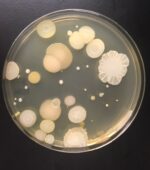
Any bioprospecting program will yield an overwhelming diversity of microorganisms. From this candidate pool, the BiOWiSH team uses our proprietary set of laboratory screening protocols to identify Endophytic Endospore Formers that are suitable for the development of microbially enhanced fertilizers.
The Next Generation of Microbial Fertilizer Enhancements
As our team continuously evaluates a constant stream of Endophytic Endospore Formers, BiOWiSH Technologies is growing a database of results from all parts of our microbial characterization and screening process. Ultimately, this database will accelerate the proposal of customized microbial formulations based on the specific mechanistic, stability, and regulatory requirements of a given application. Through a combination of new product development efforts and industry stewardship, including our work with the Association of American Plant Food Control Officials (AAPFCO) to officially recognize Microbially Enhanced Fertilizers (MEFs) as Enhanced Efficiency Fertilizers (EEFs), we are leading the charge towards an innovative, effective, and profitable future for microbial fertilizer additives.
John Gorsuch is Vice President of Research and Development with BiOWiSH Technologies. John has accomplished a tremendous amount during his 10-year tenure at BiOWiSH, including peer reviewed publications, patents, and leading the establishment of our Microbial Discovery Pipeline. John has also garnered industry recognition for his stewardship work with TFI, ISO, and AAPFCO, through which he strives to raise the standard of quality and data transparency for agricultural microbial products.

